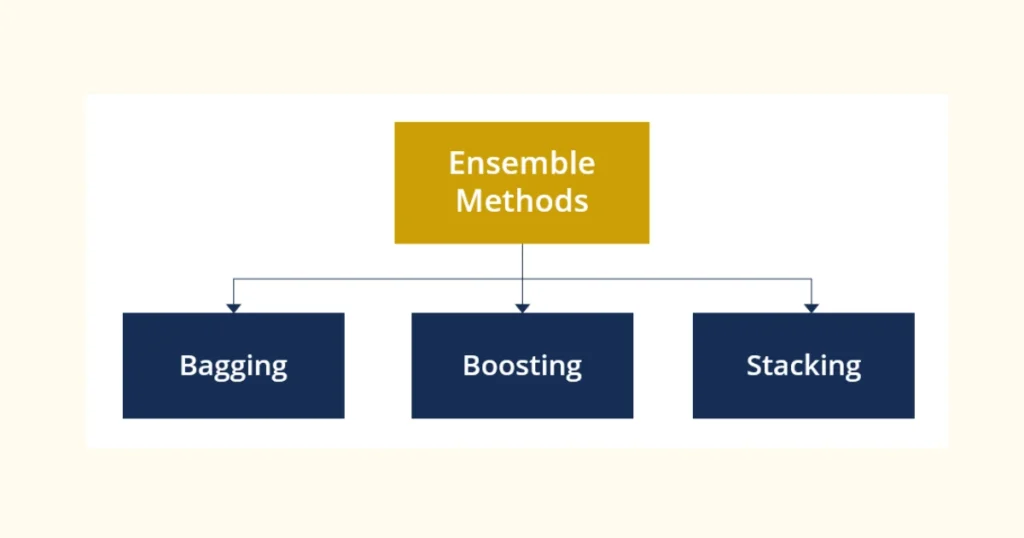Ensemble Methods in Machine Learning: Have you ever wondered why some machine learning models perform better than others even when trained on the same data? The answer often lies in one simple concept, ensemble methods in machine learning.
As the famous statistician George Box once said, “All models are wrong, but some are useful.” In the world of AI and data science, ensemble methods make models not just “useful,” but “powerful” and “reliable.”
What Are Ensemble Methods in Machine Learning?
Before exploring further, let’s start with a simple question, what are ensemble methods in machine learning?
In simple terms, ensemble methods combine multiple models (often called “weak learners”) to create one strong predictive model. The idea is straightforward: instead of relying on a single model, we bring together several models to make better predictions.
It’s like asking a group of doctors for a diagnosis instead of trusting just one opinion, more perspectives usually lead to better results. The goal of ensemble methods in machine learning is to improve accuracy, reduce errors, and make models more generalised for data.

Why Do We Need Ensemble Methods?
Even the best algorithms can make mistakes. A single model can overfit, underfit, or simply fail to understand complex patterns in data. That’s where ensemble methods foundations and algorithms come into play. They build multiple models and combine them in a smart way to minimise these errors.
Advantages of Ensemble Methods:
- Higher prediction accuracy.
- Reduced overfitting.
- Better handling of noisy data.
- Works well for both regression and classification tasks.
- Robust performance across different datasets.
In short, ensemble models are like teams, they perform better together than alone.
Types of Ensemble Methods
There are several types of ensemble methods used in machine learning, but they mainly fall into three major categories:
- Bagging (Bootstrap Aggregation): This method trains multiple models on random subsets of the data and averages their predictions.
Example: Random Forest ensemble method in machine learning uses bagging to combine several decision trees for more stable predictions. - Boosting: In boosting, models are trained sequentially, where each new model tries to correct the errors made by the previous one.
Popular algorithms include AdaBoost, Gradient Boosting, and XGBoost. - Stacking (Stacked Generalization): This technique combines different models (like decision trees, logistic regression, and neural networks) and uses a meta-model to produce the final output.
Each type has its own use case, but all share one goal, to make predictions smarter and more reliable.

Random Forest Ensemble Method in Machine Learning
Among all ensemble techniques, the random forest ensemble method in machine learning is one of the most widely used.
Here’s how it works:
- It builds multiple decision trees using different subsets of data.
- Each tree makes a prediction.
- The final result is decided through majority voting (for classification) or averaging (for regression).
For example, if 70 out of 100 trees predict “Yes” for a class, the final prediction will be “Yes.”
Random Forest models are known for being stable, less prone to overfitting, and easy to implement, making them a favourite choice among data scientists.
Ensemble Methods for Regression
While ensemble methods are often used for classification, ensemble methods for regression are equally powerful. In regression problems, these methods combine multiple models to predict continuous values more accurately.
Common approaches include:
- Bagging Regression: Averages predictions from different models.
- Boosting Regression: Focuses more on data points with higher prediction errors.
- Stacking Regression: Uses multiple regression models layered together to refine predictions.
A practical example? Predicting housing prices or stock values using ensemble methods for regression often gives more accurate outcomes than a single model.
Ensemble Methods Foundations and Algorithms
To understand the backbone of ensemble methods foundations and algorithms, it’s essential to grasp three key concepts:
- Diversity: Models must be different enough to bring unique insights.
- Independence: Models should make errors independently, not all in the same direction.
- Combination Rule: Predictions from all models are combined through voting, averaging, or a meta-model.
These foundations make ensemble techniques highly reliable for tasks like fraud detection, medical diagnosis, and recommendation systems.
A 2023 research paper in IEEE Access highlighted that ensemble algorithms often outperform single models by 10–15% in prediction accuracy.
Use of Ensemble Methods
Let’s look at some advantages of ensemble methods in action:
- Healthcare: Predicting patient risks by combining various diagnostic models.
- Finance: Detecting fraudulent transactions.
- Education: Forecasting student performance.
- E-commerce: Enhancing product recommendation systems.
These examples prove how ensemble methods in machine learning are shaping decision-making in every sector today.
Read More: Ensemble Learning in Machine Learning: Types, Techniques & Benefits

Challenges and Limitations
Of course, no technique is perfect. Ensemble methods, though powerful, come with challenges:
- They can be computationally expensive.
- Hard to interpret due to multiple models working together.
- Require more time for training and tuning.
However, the performance improvement often outweighs these issues, especially in complex projects where accuracy is a priority.
On A Final Note…
In a world full of data, depending on a single model is like betting on one player to win an entire match. Instead, ensemble methods in machine learning create a team, each model contributing its strengths and covering others’ weaknesses.
So next time someone asks you, “What are ensemble methods in machine learning?”, you can confidently say: “They are techniques that combine multiple models to make predictions smarter, stronger, and more accurate.”
Or as one might say in data science, “The wisdom of the crowd works even for machines.”
FAQs
What are ensemble methods in machine learning?
They are techniques that combine multiple models to improve prediction accuracy. Common examples are bagging, boosting, and stacking.
Why are ensemble methods used?
They reduce errors, handle noisy data, and increase model accuracy. Ensemble learning helps overcome the weaknesses of single models.
What are the main types of ensemble methods?
The types of ensemble methods are:
Bagging
Boosting
Stacking
Each uses a different way to combine models for better results.
What is the random forest ensemble method in machine learning?
It builds many decision trees and averages their predictions. The random forest ensemble method in machine learning gives stable and accurate outputs.





